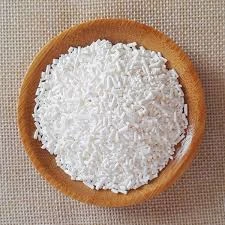
sodium metabisulfite
Sodium Metabisulfite An Overview
Sodium metabisulfite, also known as sodium pyrosulfite, is a white, crystalline powder with the chemical formula Na2S2O5. It is primarily used as a preservative and antioxidant in various industries, including food and beverage, pharmaceuticals, and photography. This compound plays a crucial role in prolonging shelf life, maintaining color, and enhancing the quality of products.
Chemical Properties and Structure
Sodium metabisulfite is an inorganic salt formed by the reaction of sulfur dioxide with sodium carbonate. In its solid state, it appears as a white powder or granules and has a strong sulfurous odor due to the release of sulfur dioxide when heated. It is soluble in water, forming a solution that can release bisulfite ions, which are responsible for its reducing properties.
The molecular structure of sodium metabisulfite allows it to act both as a reducing agent and as a source of bisulfite ions, which can react with a variety of other compounds. This versatility makes it valuable in many applications, particularly where it is essential to manage oxidation processes.
Applications in Food and Beverage Industry
One of the most common uses of sodium metabisulfite is as a food preservative. It is widely used in the winemaking industry, where it serves to inhibit the growth of unwanted bacteria and fungi. By preventing oxidation, sodium metabisulfite helps maintain the desired flavor, aroma, and color of wine. In dried fruits and vegetables, it serves a similar function, preventing browning and preserving freshness.
Additionally, sodium metabisulfite is used in the production of certain types of beer and soft drinks
. Its antioxidant properties help to prevent spoilage and extend the shelf life of these beverages. When used in concentrations that comply with regulations, it poses minimal risk to consumers, making it a popular choice among food manufacturers.Role in Pharmaceuticals
sodium metabisulfite

In the pharmaceutical industry, sodium metabisulfite serves as an antioxidant and a preservative in various formulations. It helps prevent the oxidation of active ingredients, ensuring the stability and efficacy of medications. For instance, it is often included in injectable formulations to enhance the shelf life of sensitive compounds. Additionally, its reducing properties can help in the synthesis of certain drugs, contributing to the production of high-quality pharmaceutical products.
Photography and Other Applications
Beyond food and pharmaceuticals, sodium metabisulfite has historical significance in photography, where it was used as a developing agent and a preservative for photographic chemicals. Although digital photography has largely supplanted traditional film processing, sodium metabisulfite remains relevant in some specialized applications.
Moreover, sodium metabisulfite is utilized in various industrial processes, including water treatment and textile processing. Its ability to react with chlorine makes it effective as a dechlorinating agent, while its reducing properties find applications in the bleaching of textiles.
Safety and Regulatory Considerations
While sodium metabisulfite is generally recognized as safe when used within regulated limits, it can cause allergic reactions in some individuals, particularly those with asthma. Consequently, food products containing sodium metabisulfite often carry labeling requirements to inform consumers. Regulatory agencies, including the U.S. Food and Drug Administration (FDA) and the European Food Safety Authority (EFSA), set specific limits on its use to ensure public safety.
Conclusion
Sodium metabisulfite is a versatile compound with a range of applications across various industries. Its role as a preservative and antioxidant significantly impacts food quality, pharmaceutical stability, and industrial processes. While it is considered safe under regulated conditions, awareness of potential allergic reactions is essential. As industries continue to emphasize safety and quality, sodium metabisulfite will likely maintain its importance as a valuable ingredient in many formulations. Its ability to improve product longevity and preserve essential qualities ensures its enduring relevance in modern applications.
-
Why Glacial Acetic Acid Food Grade Is Essential in FlavorNewsMay.26,2025
-
Surging Export Growth of Food Additives in ChinaNewsMay.26,2025
-
How Ammonium Nitrate Fertilizer Boosts Crop YieldsNewsMay.26,2025
-
How 1,2,3-Benzotriazole Shields Plastics from UV DegradationNewsMay.26,2025
-
Cyanide in Gold Mining: Protecting People and the PlanetNewsMay.26,2025
-
Aluminum Hydroxide in Modern Sunscreen FormulationsNewsMay.26,2025
-
Understanding Synthetic Rubber OptionsNewsApr.27,2025
Hebei Tenger Chemical Technology Co., Ltd. focuses on the chemical industry and is committed to the export service of chemical raw materials.
-

view more DiethanolisopropanolamineIn the ever-growing field of chemical solutions, diethanolisopropanolamine (DEIPA) stands out as a versatile and important compound. Due to its unique chemical structure and properties, DEIPA is of interest to various industries including construction, personal care, and agriculture. -

view more TriisopropanolamineTriisopropanolamine (TIPA) alkanol amine substance, is a kind of alcohol amine compound with amino and alcohol hydroxyl, and because of its molecules contains both amino and hydroxyl. -

view more Tetramethyl Thiuram DisulfideTetramethyl thiuram disulfide, also known as TMTD, is a white to light-yellow powder with a distinct sulfur-like odor. It is soluble in organic solvents such as benzene, acetone, and ethyl acetate, making it highly versatile for use in different formulations. TMTD is known for its excellent vulcanization acceleration properties, which makes it a key ingredient in the production of rubber products. Additionally, it acts as an effective fungicide and bactericide, making it valuable in agricultural applications. Its high purity and stability ensure consistent performance, making it a preferred choice for manufacturers across various industries.











